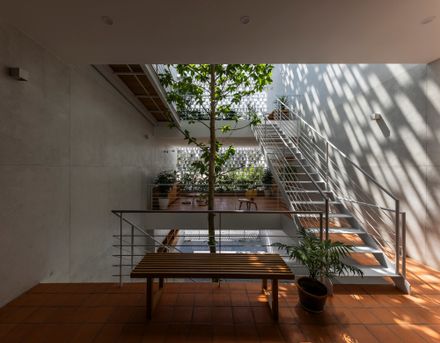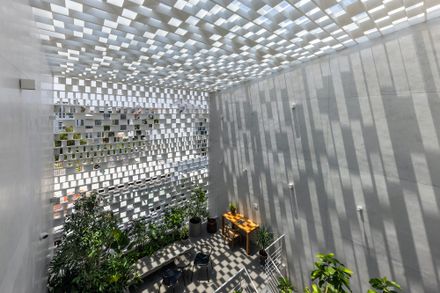
Vung Tau House
ARCHITECTS
Sanuki Daisuke Architects
LEAD ARCHITECT
Sanuki Daisuke
PHOTOGRAPHS
Hiroyuki Oki
AREA
139 M²
LOCATION
Vietnam
YEAR
2024
CATEGORY
Houses
LIVE IN THE URBAN BLANK
This is a private house in Vung Tau, a provincial city in southern Vietnam.
The site is a typical tube house type, with both sides and the rear of the house closed off from the neighboring houses, and no ventilation or lighting can be expected from the side openings.
The front facade faces west, subjecting it to intense tropical sunlight in the afternoon, which can create an uncomfortable living environment.
Despite these challenges, Vietnamese homeowners desire a home that feels open and lush with greenery.
It is said that about 80% of the houses in urban areas in Vietnam are in the nhà ống (tube house) style.
These structures are typically built on strip-shaped plots measuring 4 to 8 meters wide and about 20 meters deep, often rising 4 to 6 stories without shared walls, resulting in closely packed buildings that create a dense urban fabric.
Only the front of the house is open to the street, and the other three sides are closed to the outside air, so the main theme of the tube house design is inevitably how to incorporate natural light and natural ventilation.
We have been studying a prototype model of a tube house in Vietnam for many years. We are creating a typology of a cross-sectional model that divides the house into enclosed private volumes and other open common spaces, tailored to the Vietnamese climate to enhance natural light and airflow.
In the low-rise, high-density urban areas of Vietnam, we believe that it is very important to consider how to convert the dark and dreary living environment into a bright and open living environment for urban residents in Vietnam.
Our idea was simple. We defined the entire site as a "blank" left between the neighboring houses, with the first floor as a platform containing playrooms and private rooms, the open floor slabs inserted above the second floor, and the roof and facade covered with light steel shades.
The floor slabs differ in level and depth at each location, and various spaces are created from the overlapping of each.
In particular, the facade side, where the slab is cut into a large area, is a three-dimensional front yard with a continuous atrium from the first floor, and together with the atrium in the rear, it creates a pathway for cool ocean breezes to flow into the interior of the house.
This idea was developed through the study of tube house prototypes and is the result of our efforts to create an open living space that incorporates outdoor space, a characteristic of traditional Vietnamese residences.
A 10m tall White Champak tree is planted in the front yard atrium and is surrounded by a circulation system of stairs and bridges.
The trees and the garden can be seen from anywhere in the house, and the living/dining rooms and bedrooms on the second to fourth floors are firmly connected to the front yard through movable partitions such as sliding and folding doors.
In other words, rather than having a garden as part of the house, the entire house is a garden, giving the impression of living in a part of that garden.
The front yard, covered with trees and shades of various sizes, is a buffer zone from the west façade while allowing light into the building, thus preventing direct light from entering the bedrooms and other rooms.
The shades are made up of several different types of angled panels that are stacked to create a variety of patterns that vary with the time of day.
Children can run around under the light coming through the shades and enjoy the tropical trees growing day by day and the pleasant breeze.
This is a proposal for a house integrated with the outdoors in high-density Vietnam.




















































